#will link the paper in the research ref post
Explore tagged Tumblr posts
Text
So you may know that Shackleton's brother is suspected of having stolen the Irish Crown Jewels (clown ass colonial bs) but did you also know that he was gay and really funny?

This article is from 2008 so like by no means recent. It's almost legally an adult.. anyway, here's what went down:

The jewels were taken from a safe with a key. The guy (british establishment) with the only 2 keys didnt talk while he was alive, eventually got shot by irish nationalists and in his will claimed that Frank Shackleton had done it. And also this:

So yeah. Based!
#in the 21st century ernest n francis would have been the ultimate scammy startup bros. convince me otherwise#quip#shackleton#frank shackleton#francis shackleton#ernest shackleton#ireland#yay#anyway. shackleton died like 3 days before the treaty for the irish free state was ratified. much to consider#forever trapped in the empire#research#will link the paper in the research ref post#*article. not paper
13 notes
·
View notes
Text
some of you asked if you could print/chew/otherwise consume my Devil's Minion art, and i did ask if you needed a masterpost on the topic, so-
may i offer you this Google Drive folder, o gentle creatures..?



i'll add more, and i believe it's sensible to add the links to the original posts with these images, but frankly speaking i am chill with whatever way you use or share them if that's for your personal use
just keep them free, that's my only request
what was born as a free art should remain free art
any questions left? ask them, i don't bite unless you would really like that
now, have a peaceful day and my digital hug
💜UPDATE💜
it feels appropriate to make it a fully shaped masterpost, links and all, so... links to each and every artwork on the theme - below the cut
the Tarot cards (Hermit/Death)
"...rest" (but mirrored)
first take on Armand that looks like anime
some thoughts on the age of the magnolia tree
human!Daniel deliberately thinking of beautiful things
The Magnolia Tee Print
animated Daniel (literally, as in, a gif)
a very vampire!Daniel, thoroughly researched
Byzantine Icon Armand
a tender moment which is vague but there you go
sleeping Armand from a fic
hugs (the quiet)
more hugs (abrupt)
more hugs (headphones on, updated)
Daniel gently cleaning Armand's face
some extra somfte quiet gremlin
crack!chibi!Daniel on tees
crack!chibi!Daniel on teefs
sneaky sleepy uncertain hug for another fic
moar tender touch for another fic
beige pillow
the return of the beige pillow
"i see you"
kissing the maker's hand
more tender face-touching, couldn't choose one
Daniel comes to Louvre
Daniel collects art
four pages of Armand running and Daniel chasing
Hug The Gremlin
Hug The Gremlin For He Is Art
Armand as a candle, literally
Armand and magnolia petals (the art)
Armand and magnolia petals (the sculpture)
(slightly off-topic, but) Perforated Heart because ffs Eric knows his shit
good old don't you maître me thing which i keep forgetting to include
Only Fangs Molloy - keep in mind there's a JPEG and a TIFF version in the Drive folder, the TIFF works better if u wanna print it
(+bonus TALK SHIT GET BIT file is also there)
A LOT of traditional stuffs, scanned in 350 dpi for your entertainment
Daniel gently feeding his feral master, which is honestly one of the most tender things i have created
cozy sated hugs on a sofa
a domestic scene of Daniel waiting for Armand to enter his space, i suck at descriptions
trad art bonus! fighting with graphite dust, vol. 1, Luke
trad art bonus! fighting with graphite dust, vol. 2, Assad
an inspired old dogboy Molloy because face it, the world needs more hot aged people
trad art bonus! fighting with graphite dust, vol. 3, Armand
trad art bonus! Salomé Armand (+ vid)
MORE trad art! sculpting dat old hot man
what happens when you use ur own slightly inaccurate sculpture as a ref
EVEN MORE trad art!! Eric vs. watercolours, for his face compels me and his wild ig inspires me (+ vid)
TRAD ART AGAIN, since i found paper that looks like fun base for bookmarks (+ vid and bonus Daniel)
"he is behind my back, isn't he" (+ linked explanation)
tbc🫀
"he is 100% behind my back and i have ideas about it 😈"
#art is a coping mechanism#this gives me serotonin#fan art#interview with the vampire#daniel molloy#eric bogosian#armand x daniel#armand de romanus#vampire armand#armand#assad zaman#iwtv spoilers#iwtv art#iwtv fanart#amc iwtv#iwtv#devils minion#devil's minion#what makes you fascinating#masterpost
2K notes
·
View notes
Text
My AU & Headcanon
In this post, I'm going to explain many details about how I see the Winx universe. This post will be updated regularly.
A few words of introduction. 🍄
Hello there, I'm Sam. I'm 25 and I live in Paris, France. I have a degree in English literature, and most precisely as a researcher in American literature. So, yes, I love reading and writing. 🧡
Kimii used to be my user name when I was twelve. I used to have a french news account on Winx club. (does it still exist? Nope... the website shut down in 2023). So when I created my account here, I just kept it. It's a sort of identity I embraced my whole teenage years, so it made sense to keep it. It's my Winx Identity.
For the language, I write in English. I may be fluent, but I can leave some mistakes here and there. If you notice any big ones, please feel free to send me a DM. Thank you very much. It can be hard sometimes to notice them.
The Winx Club I grew up with. 🌚
The first thing I think is essential to know about my writing, is that I grew up with the only french dub existing, which is based on the original one (Rai Italy). I stick a lot to the original plot while I try to make it more conherent and consistent.
Headcanon or Canon? ☀️
I'm mostly canon at first sight. Indeed, I stick to the original plot, but I also tend to modify details, timelines, or events so it makes more sense. I like to change those details enough that the story holds more realism and maturity.
One of the major things I do when I keep the original plot is that I add the details given in the comic books. For those who didn't read them, the main storyline is similar (Bloom looking for her parents, etc...) The comics feel more like filler episodes. That's why I like to add those details to my stories. For example, Bloom has a job in Magix. It is shown in the comics but not the cartoon. This detail makes sense as we see in season 4 that the specialists exchange valuables for paper money. The same goes for Bloom, she works in order to have Magix's currency.
So consider my Winx canon as a mix of both comic books and of the cartoon.
I write a lot about Bloom & Sky, (oops ?🤗) since they are my favorite. I have many, many, MANY ideas for them. So it won't be very balanced between the pairings 😶 However, I do accept prompts and requests for pretty much every character.
Most, if not all my stories are linked. I like to build a consistent timeline. So if you happen to read all the oneshots or longer ff, you will notice some ref to older ff or oneshots I posted. On my main post, always make sure to include a set timeline so it gives you an idea of where the scenes take place. After season 4, I don't acknowledge anything. Not even the second movie (I liked it a lot but it is a huge problem in my timeline since the dubs are all over the place...)
For the stories that happen in the future, those would be more headcanon. The pairings might be canon most of the time, the plots would be so advanced that I don't think they can be considered canon. Plus, I love world-building.
Information on some characters. 🌈
Musa & Tecna: not royals in my AU. They are not introduced as such in the Rai version. Plus, I much prefer them as "normal people" as it brings even more diversity to the cartoon. I would hate to have most Winx girls being princesses... For Tecna, I want to work on her as half fairy, half android. Just like she was supposed to be.
Riven: Oh Riven.... I have a sort of affection for him. Like a soft spot for who he could be if the writing of the show had given him more time to grow. I will work on that. You have my word. Not only do I want him to have a past, but also a future. I see him doing great things.
Aisha/Layla: In the french dub, she is called Layla, but I really like Aisha because we love diversity here. Plus, Aisha has a beautiful meaning!
Sky: In my AU, he stays Brandon at the beginning and then Prince Sky later on like in the original. I plan on writing a few oneshots about what if he had been "prince Sky" from the beginning, or if he had never attended Red Foutain (I really like that one hehe).
Helia: I like the idea of Helia being a bit cold and blunt, like at the beginning of season 2. (or at least he was in French). That man did not care about anybody but Flora and I loved that. So I will work with him in that way.
Diaspro: I get that most fans tend to redeem her a lot, but I think her arc in seasons 1, 2, and 3 is brilliant. Although the path of the narrative did not allow her to grow a little bit or even explain why she behaved the way she did. So, my Diaspro is still... Well Diaspro, but I want to build her more realistically. She is an interesting character. Her being a fairy and yet being manipulative and self-centered is much more realistic. It brings a lot of dimention to the magical world. Wwhat if she was forced by conventions and traditions to be a fairy, because of her nobility ? hmmm... You will have to wait and see.
Nabu: Don't talk to me, he will live on forever on this Tumblr. While I love him, and I adore his sacrifice, I can't let go of him. He is just sleeping, Okay. Now move along. 💨
Samara and Erendor: I have read @gins-potter fanfic (go read it! ) and she made me remember one of my childhood frustration. Why in the world does Sky look nothing like his parents??! Erendor looks like... Brandon? She actually changed their appearance, which I loved. I want to keep Samara as she is, but maybe Erendor will have to suffer a rendez-vous at the hairstylist. And @gins-potter agreed to let me use her depiction of Erendor since it feats perfeclty the way I imagined him.
Domino/Sparx: I will only use Domino as it is the name I always knew. Same for Melody.
When it comes to the Winx and their life after Alfea, I have a very detailed idea of their jobs and position etc... I will either do a post abour it, or just let you guys discover more about it in the stories.
Last Update: 17/06/24.
#winxclub#winx#winx club comics#canon#headcanon#writing#winx fanfic#fanfiction#oneshot#skloom#winxfanfiction#writeblr#ao3 writer
10 notes
·
View notes
Text
'Reading Boulware'
~"THE DAWN OF RULE"~
Did You Know That:
People in 123 countries have read your papers and you currently have 1,588 total Stedfast readers? You have also been mentioned/cited multiple times by many readers and researchers; i.e.: Mentioned by Whyte H Ibidapo; cited in International Law papers, cited in a Civil Law paper; cited in Human Rights papers uploaded to Academia? Gregory, your posts received 241 impressions last week on 'Linked In' Last week! The "Top Performing Post Last Week:
~"THE DAWN OF RULE"~ "Human-Kind has been enslaved by Sin and Death…" https://www.academia.edu/36702533/The_Dawn_Of_Rule https://independent.academia.edu/GregoryVBoulware https://www.google.com/search?q=THE+DAWN+OF+RULE%2C+Gregory+V.+Boulware&rlz=1C1GCEA_enUS1090US1090&oq=THE+DAWN+OF+RULE%2C+Gregory+V.+Boulware+&gs_lcrp=EgZjaHJvbWUyBggAEEUYOTIHCAEQIRigATIHCAIQIRigATIHCAMQIRigATIHCAQQIRigAdIBCjE1MzU4ajBqMTWoAgCwAgA&sourceid=chrome&ie=UTF-8#ip=1 Have You Read 'Boulware?' Take a look, see what you've been missing and what you may gain…Reading is the Brain on "UpGrade!" "Amazon" http://www.amazon.com/Gregory-V.-Boulware/e/B00OI16PDI/ref=ntt_dp_epwbk_0

#Boulware#BoulwareBooks#SCSEP#MCOA#NCOA#CCPedu#BereanInstitute#IndependentBlackMedia#Juneteenth#UncleBobbiesCoffeandBooks#ArchitectsOfChange#Anthology#Hallow#HallowII#Fairmount#AI#Robots#PhilaBear#DelaBear#Bear#Bruin#TheOneThingIKnow#SpiritOfTheSoul#MadeForMinds#EzineAuthors#The3rdEye#TheSeed#Germantown#Philadelphia#HBCU
0 notes
Text
On Doing Your Own Research in News and C-ent in General
Recently, a user on the bird app posted a PR-like guideline for the international audience to use when discussing ZZH's situation:
Here. It's pretty well written and keeps the points simple when talking about ZZH's situation. The user also cautions not to come out and attack anyone or start something over it, these are just points for rationale/short clarifications and conversations. It's currently available in English, Vietnamese, Russian, Portuguese, Korean, German, and Thai (probably more later).
I see the phrase "doing your/my own research" flying around a lot, and I realize that many people don't know how to do that. News has become increasingly harder to consume because many people are not trained or do not have time to consume media critically, and then it's easy to be fooled by some bad players. From someone who has extensive background in the research sciences, I would like to share some tips and thoughts on media & the Chinese entertainment industry (c-ent).

Table of Contents: How to keep yourself from getting fooled by controversial news
1. Follow the Money - western and c-ent
2. Cross Ref Facts
3. Verify Sources - who am I?
4. Read Primary Articles
5. The Case of a Certain Celebrity (ZZH)
Below the cut to keep reading:
1. Follow the Money
Every news source is invested in getting user views to generate income. Understanding the corporate interests that are invested in each news source will let you understand the limits of that source's perspective. For example, I often read The Washington Post, a renowned newspaper. To publish in this paper requires some form of notoriety/editing/fact checking, so I can rely on that. However, it is also owned by Amazon, so if it publishes things involved with Amazon or Amazon competitors, I will have to double check with some other source, see other perspectives. Why? Because it might have a vested interest in keeping Amazon happy, which might mean a bias towards it, etc.
-What about smaller news sources that don't have a clear money interest?
If we look only at social media accounts for news, it is much harder to see what their sources are and what motivates them. So for these, I would say simply make a note in your mind on what's happening, but don't go further than that. There's really no way for you to confirm until other larger outlets / the authorities do their own investigations.
Note on C-ent from someone who doesn't speak Mandarin:
Sadly, I have to rely on secondary accounts of news to see what's happening in c-ent. Even when topics on weibo/chinese media are posted with original sources, the machine translation/google translations often don't make too much sense? If you've tried this before, you'll know what I mean. You can still find out what source that news is coming from though.
Is it coming from the Chinese government? Yes? It's probably biased to keep the government's power absolute. Note it.
Or a melon/gossip account that gets paid to make up rumors? Yes? It's probably trying just to get views and $$$. Ignore.
Or is it from a solo/anti fan who is invested in spreading negative media? Yes? Ignore.
So in this case, I would use the best tactic: wait and see - watch many accounts and see what they say before you decide or say anything yourself. Ask questions, ask clarifications. DO NOT make judgments.
2. Cross referencing facts
If you see a particularly "hot" or scandalous topic flying around, I recommend checking other channels to see if it's also been reported on. Unfortunately, news nowadays happens very quickly with very little background checking, so the news outlets may just be copying each other. Normally, I'd check CNN/WaPo/New York Times/MSNBC/etc to see how it's reported. Then if you want to check another, more conservative perspective, you can check Fox News (I suppose), but I'd be very careful since they're not known for their fact-checking prowess.
C-ent note: since I don't speak Mandarin, I rely on a bunch of different sources on Twitter/Tumblr to translate and link news. This in itself is flawed because I am seeing it through the translators' eyes, so there's bound to be bias. However, it's still valuable because you can compare different accounts of what happened.
Did "A" translate this article to mean this?
Did "B" also say the same? If it's different, why? Are the two accounts antis or solos? CPFs? Neutral? If the news is translated the same, it's more likely to be real - but not confirmed yet so hold your horses.
All these questions are useful when consuming media via a third party. Again, if the news is too fresh like it's only been 1-3 days, it's probably highly biased. Only time will tell what really happened.
3. Verifying Sources
Who is writing the piece of media/news that you are reading? Is it from a professional source? From a well-known university, newspaper, journalist, or verified eyewitness/video? From a nonprofit organization?
Or is it from a random tumblr blog like mine? Haha, take what I say with a grain of salt as well because you don't know my identity, my vested interests, or anything about me. I can say that I am an older Asian American with progressive biases whose education was mostly in the biochemical sciences + digital art media. But there's no proof, and you don't have to believe me if you don't want to. I've just been trained for a long time to think critically in this way.
All your answers to these questions will tell you how much you can rely on that piece of media.
4. Read Primary Articles
As much as you can, read a *primary* article. What is primary? It means from the ORIGINAL source, the author. It could mean an actual statement from the victim, a verified eyewitness, or from government investigations. In both science and other news media, it is the most reliable thing to read the primary article. This is because I can read exactly what the author is saying and look at their sources directly. I can judge three things:
Tone - VERY important. if the article is written with inflammatory language like extreme words (righteous, traitor, treason, shame, betray, always, never, completely, "national dignity", notorious, infamous), then I already know to expect this article is highly biased and/or just parroting other accounts. It's trying to get a rise out of you, and trying to get you to share the article with more people + generate views and $$$.
Sources referenced + Evidence used - If the source is referencing another source, which references another source... etc, it's probably not reliable (and not a primary article). If the only evidence it uses is a photo, then... what? Am I to assume all the knowledge they provide is the real context for the photo? No. This primary article, then, is assumption-heavy.
Author's identity and biases - What does the author have to gain? Who are they? Is trashing a certain person/event beneficial to them in some way? For clicks/views?
5. An Example of a Certain Celebrity
For example, let's say a random twitter/weibo account starting talking about a certain celebrity visiting a supposedly controversial area-of-interest in a country whose history is fraught with controversy. They post a photo that holds almost no context and is not instantly recognizable for most people. The photo contains a person posing in front of cherry blossom trees, a Japanese-style building, and maybe some foreign signs and other tourists.
With no knowledge of this area, the average viewer may decide to trust what this random twitter/weibo user says. However, we know how to read these bits of news now---
Let's go through the steps:
1. Follow the money
Who posted this? We don't know? Let's ask, is it possible this is from a melon account, hired "reporter", with no prior professional standing and integrity in news media? Yes? Then I can be careful in reading their news. What if I don't know the language? Then wait. It will be translated by multiple people no doubt, compare those translations. If they same the same thing, then you can continue reading what they wrote. Keep a level-headed mind and slow down.
2/3. Cross reference the facts & verify sources
The random twitter/weibo user references the Chinese equivalent of wikipedia. I know that wikipedia can be edited by anyone, and thus contain misinformation, it's not the best source to cite. So this piece of evidence is already iffy. The twitter/weibo user then references national events from the historical record as part of their argument that the celebrity did something wrong. This is usually known and kept as fact in most ppl's minds. However, it's not really evidence of any wrong-doing because it's merely referencing history that is not directly related to the celebrity. Then I would think, wait. Why would this user try to rile me up and get me angry from older history? Ah, so I would share this news, get them views, get them clicks and likes, and make them $$$. Not only that, I would think, maybe they have an agenda against this certain celebrity? Already untrustworthy news source.
4. Tone/Identity/Bias
The tone of this news seems vague on purpose. Many accounts retweeted/relayed the information that he visited some shrine with some background and only gave a few pictures of a supposed remote area most people aren't familiar with. Why not use direct words? Why leave room for implication if it was really what happened? So that people can fill in the blanks with their own imaginations and assumptions? So they can feel righteous indignation that this celebrity is somehow unpatriotic and "offended the feelings of the nation"? Ah, so this news was written this way intentionally - to rile people up.
Identity and bias are harder to discern because I wouldn't know mandarin, I'd rely on translators to do that work. Then, because I would wait to see and judge the real events, it would come out that this account and many others were paid/hired accounts to spread misinformation and gain $$$ via the downfall of that celebrity.
It was a grand campaign of misinformation and disinformation to collectively shut down a competitor in the industry, to make the gossip accounts tons of $$$, and to flex on everyone that they can control the national consciousness with a few well-placed, well-timed, edited, misinformed photos and articles.
----------------
Quick note on feeling indignation about JP/CN history: I want to note that it's valid to feel offended and hurt about the history between Japan and China depending on who you are. It's normal, feel it. But don't let others take advantage of you and your feelings. They have their own agendas in making you feel this way. Wouldn't you be tired of being constantly called upon to feel outrage? I would.
-----------------
This got longer than I expected, but I hope it helps you when you consume your next bit of controversial news. Remember to slow down, wait, and see.
14 notes
·
View notes
Text
Vertebrate Wings, PART 2: Membranes and Feathers
Return to main post + TOC >>HERE<<
Membranes and Feathers TOC
Membranes
Feather Arrangement
Feather Layering
Feather Shape
Combinations
Membranes
A common question I see in relation to bat-like (and sometimes pterosaur-like) wings: Can a creature fly if the wing membrane only attaches to the armpit of the wing? Can massive wings make up for the lack of membrane?
Short answer: No.
Long answer in the form of a numbered list of problems with these sorts of wings:
1) Wing membranes (and feathers) need to SUPPORT and STABILIZE the whole animal’s body in the air. Without membrane attached along the length of the body, the torso is left to dangle limply and awkwardly below the wing shoulders. This couldn’t work because:
a. As I explain in more detail in the Full-body Integration section, flight is a ~primarily~ horizontal affair (the obvious exception being hoverers, but I cover this in the Flight section). A limply-hanging body would increase drag and air resistance to an absurd degree compared to the typical streamlined body position of a flying bird or bat. While flight is primarily driven by the wings, it really is a full-body affair.
b. The weight of the ENTIRE creature would be localized to the wing shoulder, which would make for excruciatingly painful flight at the VERY least. The membrane helps distribute the weight of the body over a wider surface area so that no one centralized point is pulling too much weight. (again, hovering flight is an exception to this, but this is largely due to the tiny body weight of a typical hoverer)
2) ~Generally~ evolution is lazy. The theoretical length of the wings necessary to make up for the lack of membrane would use up a ridiculous amount of energy—energy that evolution isn’t likely to waste. Especially considering that the length of these theoretical wings would have to be accomplished through lengthened fingers, which are more complicated and use up more developmental energy than simple membrane extension.
3) These lengthened wings would theoretically be freakin’ MASSIVE to make up for the lack of membrane. I can only imagine they’d be too heavy and/or too long to realistically function. They’d more likely drag uselessly along the ground as the animal attempted to use too-long muscles and tendons to lift them up.
4) “The creature wouldn’t be able to flap their wings when flying. Wings act like a lever; the less wing membrane you have close to the body, the further out lift and air resistance act on them and the more force you need for each wingbeat. If you attach wing membrane at the armpit, then so much force would be needed that the dragon would have difficulty moving them on ground, never mind during flight. Adding more arm strength to overcome it is not an option because there’s only so much muscle you can add without running into many more problems,” thank you Rahjital~
This all applies to feathered wings as well—bodies need support during flight, and these sorts of feathered wings aren’t gonna provide any.
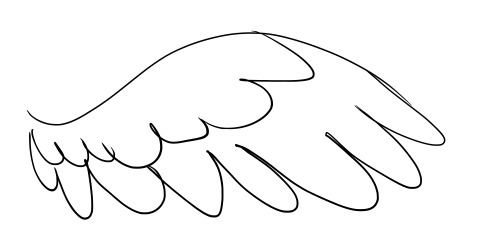
The back edge isn’t the only important part of the membrane—the front edge is highly important as well! This section of the membrane is known as the propatagium.
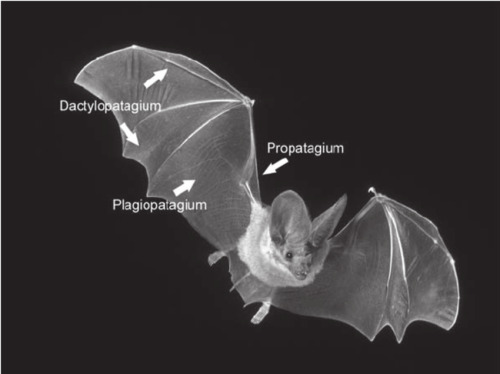
It provides a smooth, sloping curvature to the front edge of the wing (something the bare arms could not provide on their own), and helps stabilize the position of the wing through the tendon connecting the shoulder and wrist (or thumb/pteroid, depending on the wing).
This structure is present in ALL vertebrate wings—bats, pterosaurs, and yes, even birds.


It’s simply not very apparent in birds because this membrane is covered by feathers. Remember kids, bird arms aren’t rounded noodles—it’s the propatagium that gives bird wings their smooth outline!
Bats wings have hair-thin muscles across their membranes to help tense and otherwise manipulate the wing shape as needed. I actually had a hard time finding good diagrams of these muscles, sans this one EXCELLENT reference for the muscles and major veins (+skeleton) via edited versions SammyTorres drew of photo of a museum reference.
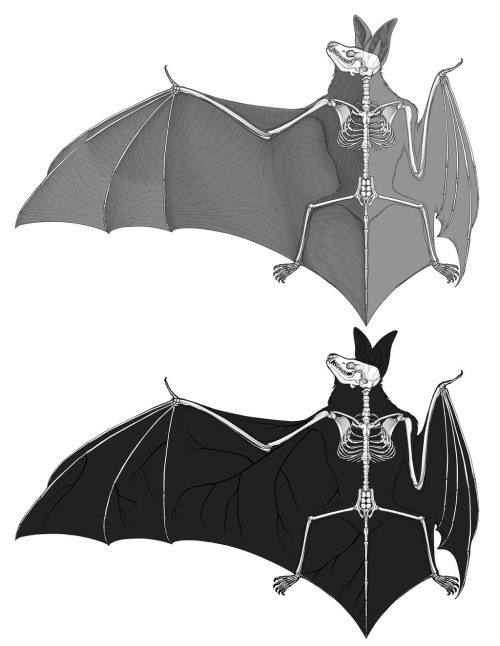
(had to cut it off to preserve image quality, but u can see the original reference photo at the link)
As for pterosaur wings, there’s still debate over how exactly the membranes were structured, but there is at least agreement on the existence of multiple layers of actinofibrils embedded in the membrane. As quoted from exdraghunt, “Pterosaur wings were stiffened with unique fibers called “actinofibrals”. These fibers can be thought of as being like the wooden battens of a paper fan, or the quills of bird’s feathers. They allowed the wing to spread out to full span, or to fold up tightly against the body, while keeping the membrane stiff enough for flight. These fibers became shorter and less regular closer to the body, so that the membrane closer to the body of the animal had more flexibility compared to the parts out at the wingtip. The fibers start out perpendicular to the arm, and shift to parallel with the wing finger out at the wingtip.”
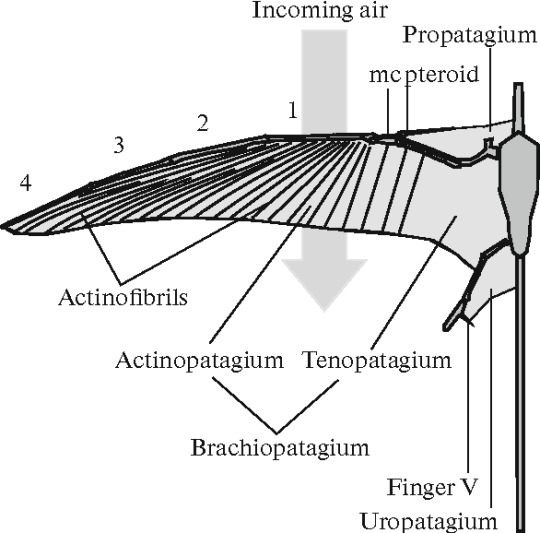
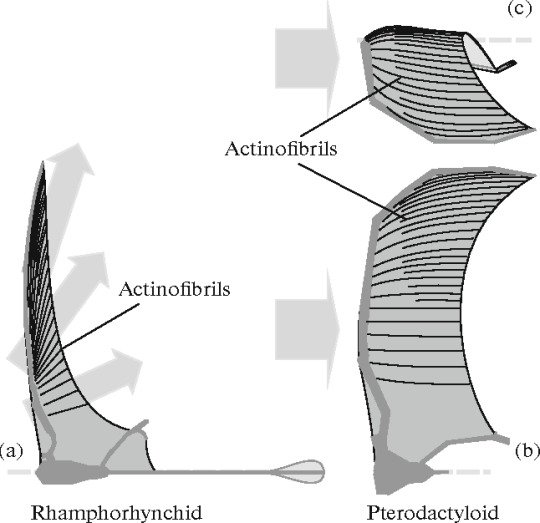
(via)
This made pterosaur membranes much stiffer than bat membranes, but still more flexible than bird feathers in terms of delicate maneuvering and camber-control.
Also, here’s a cool diagram dissecting the layers of pterosaur membrane~
Feather Arrangement
The first thing we need to get straight here is that the main flight feathers of a wing—the remiges (singular: remex)—sprout EXCLUSIVELY from the “hand” and lower arm sections of the skeleton.
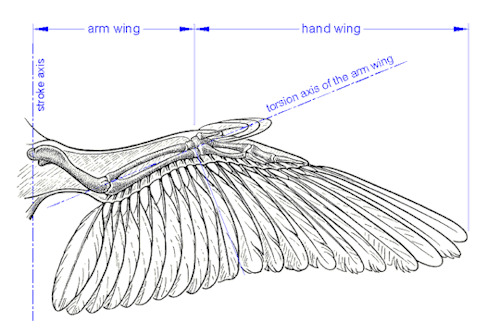
The shoulder may be the source of thrust in the wing, but the “hand” and lower arm are the actual “paddle” used to beat against the air. As we can see in the below diagram, the tertiaries (which are embedded in the FLESH of the upper arm, NOT the bone) simply fill in the space left between the remiges and the main body.
In my own research (of Googling reference photos), I’ve found that the secondary remiges tend to gradually decrease in length closer to the elbow, tapering down until the tertials are able to fill in the gaps. This may not necessarily be true for all wings, but this is the trend I’ve picked up on.
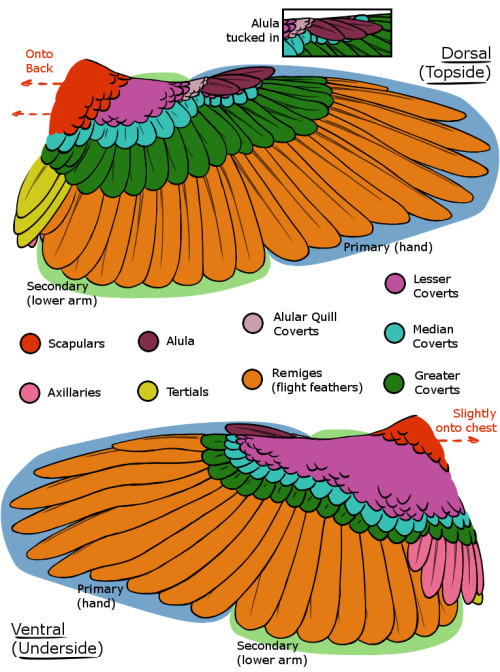
idk what the deal is, but there are almost zero references for the underside of a bird wing, so I took the liberty of making my own reference, traced/edited from these photos of crow wings. (“edited” in that I emphasized a few feather bits that aren’t quite as “pronounced” on actual crow wings, but were drawn in for the sake of illustrating their general position. the axillaries, for example, were referenced from plovers.)
The coverts (when it comes to flight) exist to smooth out the transition from arm to remex, covering the entire arm/hand section and then some.
It’s important to note that the lesser/median primary coverts DO EXIST on the dorsal side of the wing, they’re just reduced compared to the much longer greater primary coverts, so the lesser/median coverts are usually covered by the alula (this is another detail I emphasized/edited in the above ref—the lesser/median primary dorsal-side coverts aren’t actually visible with the current position of the alula on a crow wing). I don’t have references for why the feathers in this section are sized/arranged in this manner, but I think it may be due to the presence of the alula. Either way, you can usually get away with not including the lesser/median primary coverts in most wings/positions, but it is important to know they exist for those special occasions they do make an appearance.
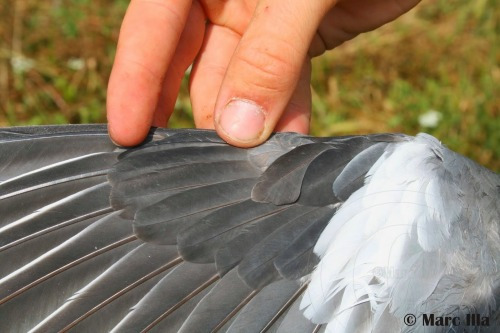
(via^)
The alula is the section of feathers that sprouts from the “thumb” of the underlying skeleton (this can be seen in the remex skeletal of the wing I posted higher up), and helps to increase lift by smoothing out air flow over the primaries. The feathers of the alula are situated on the topside on the wing, over the primary coverts and under the secondary coverts.
As a side note, the wing reference I drew is just a BASIC guide to feather arrangement. Depending on the shape and flight style of the wing, the feather “sections” can vary quite a lot, as can be seen below.
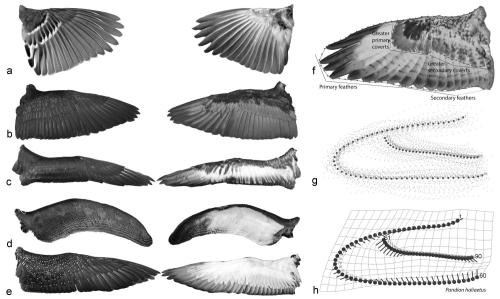
The reference I drew is just a guide to help you identify these sections of feathers in other wings more easily, even if they look quite a bit different than the wing I drew.
Feather Layering
Now for the information I’m sure you’ve all been waiting for—the detail that artists the world over struggle desperately with: feather layering.
I could just tell you all that the LEADING edge of the remiges is seen on the TOPSIDE/DORSAL view, while the TRAILING edge of the remiges is seen on the UNDERSIDE/VENTRAL view, and that will be correct.
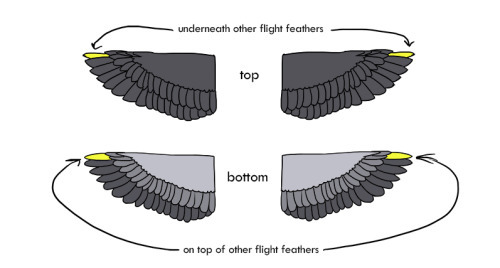
(via^)
HOWEVER, I find that I much more easily retain design information if I know WHY a particular structure is designed that way in the first place. So, here I leave you a very informative analysis of remex arrangement and how it effects flight.
youtube
While I do highly suggest watching the whole video—especially for the helpful animations—I understand that it's a long sit with dry delivery, so the main takeaway is this:
Remiges are arranged as they are in order to minimize drag on the upstroke by allowing air to filter through the feathers and under the body, thereby pushing the body up in the process.

If the remiges were theoretically arranged opposite from this, they would filter air AWAY from the body on the upstroke, thereby sucking the body down and rendering the thrust on the downstroke null.

Now, it’s important to keep in mind that this reasoning applies more strictly to the remiges compared to the other feathers. While it’s incredibly important for the remiges to be in proper arrangement, the coverts are a little more lenient, considering they just smooth out the wing. The median/greater coverts do follow the arrangement of the remiges per which side of the wing they sprout from (and lesser coverts are layered in a more-or-less “shingles” pattern), but real-life coverts tend to be a lot messier than “ideal” coverts.
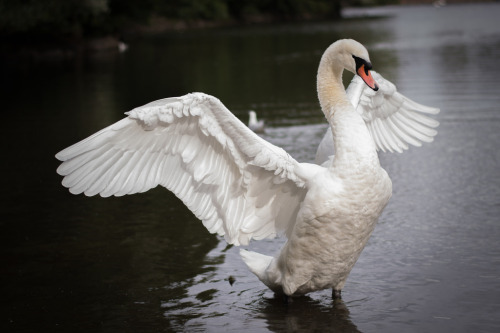
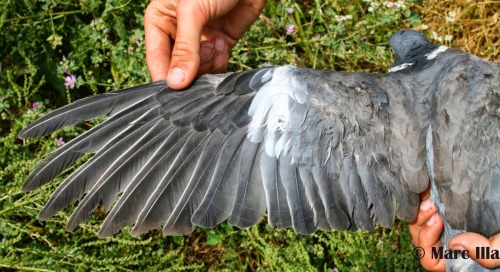
Covert arrangement (particularly that of lesser/medians) can be “goofed” a little without too much problem; It’s remex arrangement that can make or break flight.
Also note how this feather layering effects the layering of wing “sections” when the wing folds up (which will be discussed in more detail in the Positions section).
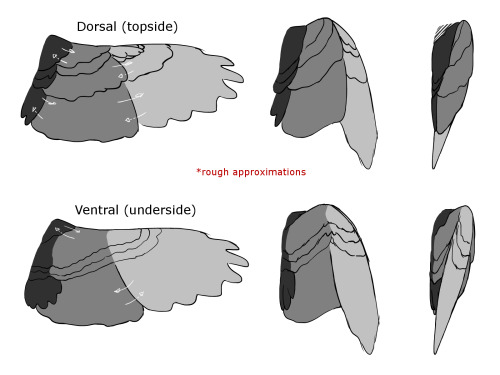
Feather Shape
Feather shape is also a critical factor in wing design (and even full-body design), BUT to tackle shape, we must first understand some basic feather anatomy.
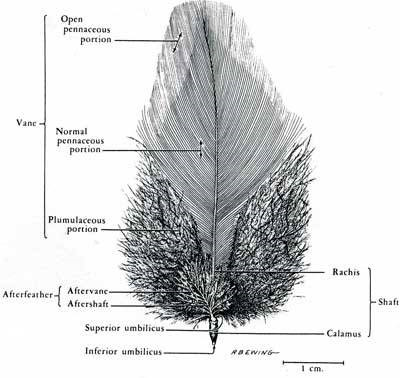
There are quite a few bits here that I’m not rly gonna get into (mostly because I myself understand feathers more in the greater scheme of a wing/body than individually), but it is important to note a few specific features, here.
The shaft is the base upon which the barbs sprout from, and where the feather itself connects to the body via the calamus(quill). Note that the barbs (at least in the pennaceous portion) ALWAYS sprout from the shaft at an outward angle. They do NOT point at a 90 degree angle straight out from the shaft, nor point backwards towards the quill, but FORWARDS towards the feather tip. This is most likely a mechanism for both reducing drag and creating a more stable interlocking of barbs.
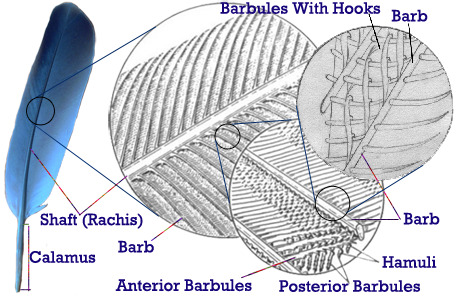
The pennaceous portion is what’s visible to the open air, so the barbs must be designed to handle what is required, such as a relative stability/stiffness for the remiges of the wings, a drag-resistant design for feathers of the body, etc. etc.
The plumaceous portion is typically hidden beneath other feathers, so isn’t necessary to draw in most designs. It’s just important to know about the fluffy plumaceous bits that exist underneath for those occasions that the feathers are lifted apart.
*note-- not all feathers have an afterfeather/shaft as shown in the first diagram-- this is most common to grouse, and is kind of like having extra down.
This is just a basic rundown of feather anatomy I’d reason to be useful to artists, but if you’d like a more in-depth discussion of feathers, I suggest this page.
Now knowing this basic feather anatomy, we can look at the diverse shapes and forms feathers can take. As has been shown in the feather types above, feathers can vary quite a lot depending on their purpose. The primary remiges, in fact, have a unique set of anatomical terms to help describe the shapes they can take.
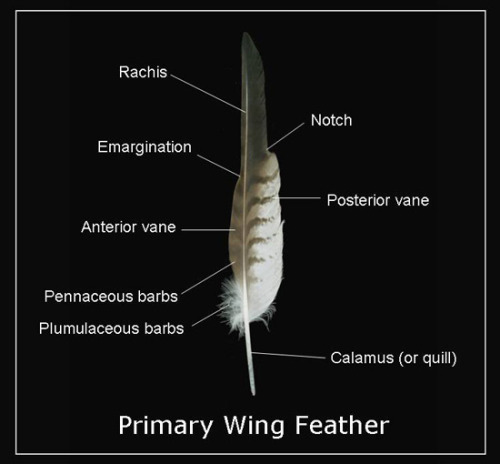
(via^)
It’s important to note, here, that at least part of the reason that the primary remiges in particular are so diversely shaped is due their being the “flight manipulation” feathers of the wings. While coverts smooth out the wing and secondary remiges provide ample surface area, it’s the primary remiges that really determine a bird’s particular style of flight (I’ll get into some of these basic flight types more in the Flight section).
It’s also important to note that the “drag direction” for any feather—remex or otherwise—is essential in planning their shape (it’s just much easier to identify in remiges). See how the barbs on the leading side of these primary remiges is much shorter than the barbs on the trailing side?
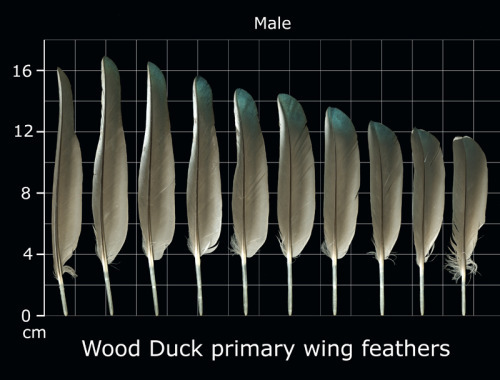
(via^)
This is because the leading side, as can be assumed, must meet air resistance head-on, so the shorter barbs provide a stiffer, more stable surface to push against oncoming air currents. The trailing side, on the other hand, provides the main surface area of the feather, so the barbs can be longer.
This asymmetrical balance of barb length changes depending on where the feather is on the wing, so it’s no surprise that the primary remex barb lengths are much more asymmetrical compared to the secondary remex barb lengths, since these barbs don’t directly push against the air on either side of the feather.

(via^)
Though keep in mind that the shafts still “lean” more towards the leading edge here, so as to properly tilt against the air on the upstroke.
This feather diversity doesn’t just apply to different feather types—even the exact same feathers of the exact same basic type can vary DRASTICALLY when compared between different species. Just look at the differences between the above wood duck primary remiges and the primary remiges of a sharp-skinned hawk below.
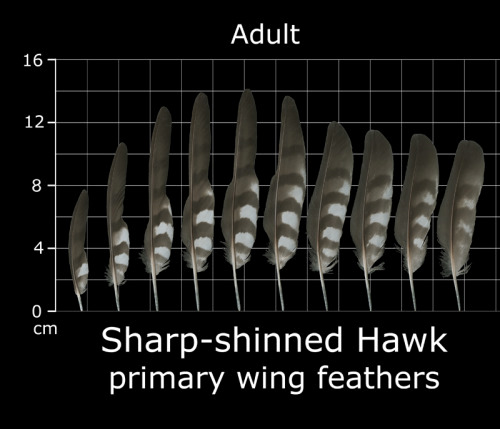
(via^)
Thus, when designing the feathers (particularly the remiges/rectrices) of a creature, you need to understand the creature’s specific form of flight, and the purpose of certain sets of feathers.
(The USFWS Feather Atlas provides EXCELLENT scans of the remiges and rectrices (main tail feathers) of TONS of different bird species, if you’d like to see more scans like these.)
Combinations
Combination feather/membrane wings are somewhat popular, and while they’re improbable I wouldn’t say they’re impossible. Improbable, because evolution would likely choose one or the other for a full wing (taking into account the energy available during development, as we’ve discussed). Or, at the very least, make the feather bits more fur-like than the rounded, complicated designs of typical coverts.
The only impossible combo-wings I could think of are webbed wings that have ALL the wing feathers—remiges included. Remiges are meant EXCLUSIVELY for flight—if the wing already has a membrane (a membrane which takes up much more energy to build than feathers), then there’s no need for additional remiges. In fact, these lengthy feathers would detract from what makes the bat wing so practical—its ability to “collapse” and otherwise bend and stretch in precise movements. Remiges would only block the bat wings’ ability to properly bend.
Not to mention, these feathers would break up the smooth/streamlined quality of these wings if they were to reach that far out over the membrane. Think about it—bird wings only have one layer of remiges, creating one smooth surface, and bats only have one layer of webbing, also creating a single smooth surface. Webbed wings with remiges on BOTH sides (or even on ONE side) would create multiple surfaces that would somehow need to lay flat against each other (but likely wouldn’t due to their nature). And that isn’t even to mention that remiges need a stable bone base to properly attach to, which the bat wrist/hand couldn’t provide, considering it already must support the fingers themselves, let alone primary remiges.
Covert feathers, on the other hand, are mainly there to create a smooth transition from the front edge of the wing to the remiges (and are embedded in flesh rather than bone). Thus, I could see their potential use in bat-like wings for the same reason, so long as they aren’t large enough to interfere with membrane/finger flexibility.
-Mod Spiral
13 notes
·
View notes
Text
Staying Organized as a STEM Student
In general, it’s nice to be (and stay) organized. There’re a plethora of tips on how to maintain your stuff, but as a stem student, it seems like it’s all too much for me - or maybe I have commitment issues, I’m not sure, but it doesn’t work for me. So! I decided to share an organizational system so to say that took me three years to develop.
Virtual Stuff
folders for your major - organized by year by semester by subjects by ppts / assignments / extras
name everything correctly
(you don’t have to colour code or date them or anything extra unless you wanna)
hard to find? pin them
(i pin my current semester’s folder + the most demanding courses separately if needed)
use bookmark manager on your web browser
how my bookmark folders are organized - engineering refs (what it is how it is why it is / past paper questions) / class (refs / books / assignment citations) / online class links / future / internship (according to projects) / volunteer work
save every page if you’re working on some research - even if it’s 43% useful
go through them later when you’re done amassing info and delete if you need to
(i find that i tend to need a couple lines from useless sites and then get mad that i didn’t save it)
with research:
※ spend an adequate amount of time amassing info first
※ this will help you brainstorm if you don’t have ideas, or refine the ones you got
※ record any ideas that pop up as you do since you’ll have come up with a rough draft in your head
※ if you do this before every report / assignment, you’ll save so much time coming up with a rough draft, going back and forth researching, getting stuck etc.
on google docs? more folders!
folders folders folders
separate appropriately and on an easy-to-find basis
Paper Stuff
keep everything
even scrap paper (will be useful later)
own one spacious folder / binder for daily use
how mine is organized according to leafs - schedule / syllabi / transcripts or score sheets / important stuff from uni / review sheets collection / several empty leafs for new courses / assignments to be handed in / returned assignments / graph paper / lab report paper / blank sheets / scrap paper
buy those pack of cheap folders for extra stuff - if you need to hand something in a folder, to hold previous stuff once you empty main binder out, to hold extra stuff at home etc.
label the ones used if you know you can’t differentiate later
organize notebooks according to schedule (if you pair a couple courses in one notebook)
keep recurring stuff within arm’s reach of your study space
keep review sheets / formula sheets of previous courses in your binder if they relate to current courses (ex: i kept my last year’s transport phenomena stuff in my folder because i was taking mass transfer last semester)
Recording Stuff
a small notebook / planner / an app to record assignments and quizzes and exams
one is enough
write the teachers / profs / doctors information on the first day in one place
date everything please
own a pack of extra pens / pencils / a set of stationery so you never have to buy any new stuff for the semester
(i legit buy them in packs and never buy any more for the rest of the semester)
do that on a good month / when the money isn’t tight
(in the middle of vacation is my time)
write everything down
spend a moment of time to make a formulae / questions / review stuff master list(s)
that will help you loads later if you start from the beginning
keep recurring stuff within arm’s reach of your study space
use scrap paper for practicing formulas / questions / review stuff - works better than flashcards if it’s repetitive, and saves time as well
The biggest takeaway from this post I would say is: doing the bare minimum is fine. You don’t need to do a whole lot to be an organized person. I can say that confidently because apparently I built up a rep of being the most organized person in my batch, and I’m just like 🤨🤨🤨
Anyways - the bare minimum is fine. If you have the little things everywhere in place, that’s enough. But!
※ do underestimate yourself
※ if not, you will lose track of your stuff
Here’s to our collective success ⁓
#study tips#study hard#engineering#engineering student#engineering studyblr#stemblog#stemblr#STEM student#stem studyblr#women in STEM#studyblr#study blog#chemical engineering studyblr#study advice#study notes#organization tips#organizational learning#organizingtips#for organizational purposes#organizational skills#organizational apps#organizational tips#stay organized#how to be productive#Productivity Tips#being productive#apathycarestostudy
18 notes
·
View notes
Text
Exploring complexity: the two sides of Open Science (II)
Pablo de Castro, Open Access Advocacy Librarian

This is the second post on the topic of Open Science and innovation. In the first one we saw how research libraries and their research support services seemed at risk of being out-of-synch with the mainstream, pragmatic approach to Open Science for the sake of ensuring the continuum between research and its practical, innovation-driven application. This second delivery will examine some of the reasons why and a couple of possible adjustments to the current workflows that would bring the libraries closer to other research support services without disrupting their present approach.
Could workflows around Green Open Access policies be fine-tuned for increased efficiency?
This being out-of-synch is a side-effect of the fact that UK research libraries are implementing what one feels is the most advanced, most successful Open Access policy worldwide, namely the (previously called) HEFCE policy linked to the national research assessment exercise (REF). This policy is totally aligned with the recommendations of the EU-funded PASTEUR4OA FP7 project, namely to make the deposit of full-text accepted manuscripts mandatory and to link such deposit to the eligibility for the research assessment exercise. Given that these were European-level recommendations, one cannot help but wonder how come the policy has not been more widely implemented despite the evident fact that 26 out of the 30 top institutions worldwide by percentage of openly available institutional research outputs as per the CWTS Leiden ranking 2019 happen to be British universities. Two main reasons come to mind: first, that no other country has dared to apply the PASTEUR4OA project findings in such a literal way. Second, that no other country has developed such an effective, almost ruthless network of Open Access implementation teams within their research libraries (there’s a third reason: no other country had the likes of Alma Swan or Stevan Harnad to pester the policymakers). So why should this highly successful national-level policy that could effectively achieve the 100% Open Access objective be an obstacle to a pragmatic approach to Open Science? Because it's a Green Open Access policy based on the deposit of accepted manuscripts in institutional repositories with widespread embargo periods. Because despite the current and future progresses in enhancing the visibility and discoverability of repository contents, the canonical way to reach a publication for an external stakeholder with little knowledge about the complex scholarly communications landscape (eg Industry) remains and will remain the DOI issued by the publisher. Because a Green OA-based policy does not open the publications sitting behind those DOIs. And because the amount of effort involved in the implementation of the HEFCE policy as it is designed right now is so huge that research libraries lack the physical resources to adopt any other complementary Open Access implementation policy. Enter Plan S with its highly pragmatic approach to Open Access implementation. Originally strongly based on Gold Open Access, APC payments where needed and deals with the publishers to address the double-dipping issue around hybrid journals, it's only after considerable pressure has been exerted by the Green Open Access lobby that the zero-embargo Green Open Access policy has found a place in the Plan S implementation guidelines. But with the current scramble for 'transformative' deals that will allow most hybrid journals to become eligible under Plan S requirements, the size of the institutional Gold Open Access output pie will only grow in forthcoming years. Caveat: one is an (European) institutional Open Access advocacy librarian and shares most of the views one's colleagues have about certain scholarly publishers. But this is a series of posts devoted to exploring complexity and the way research libraries may deliver a better service to their institutions. The big issue at the moment is that the enormous effort that Open Access teams at UK research libraries are devoting to implement the HEFCE policy – which requires them to chase every single full-text accepted manuscript for every single publication the university produces – prevents them from being able to adopt the set of workflows required for the implementation of all these 'transformative' deals. Not to mention adequately exploring enhancements in system interoperability to make sure other Open Access mandates also get implemented. Or paying more attention to the actual impact of such research outputs. It is somewhat ironic that so much duplicate effort is going on around the HEFCE OA policy implementation – with all Open Access teams at all co-authoring UK institutions for one single paper chasing repeated copies of the same full-text manuscript from 'their' authors – when the tools are already there that could make this process much more reasonable. The Jisc Publications Router, formerly known as the Repository Junction Broker, would easily allow for one AAM ('Accepted Author Manuscript' in the OA lingo) to be chased once by a single institution (ideally the one associated to the corresponding author) and brokered to all co-authoring UK institutions. This software was originally conceived and designed with publishers in mind as content providers. They would provide the AAMs for their papers, and these would then be distributed to the co-authoring institutions, very much in the spirit of the PEER project. But then all the announcements we're getting from the Jisc regarding publishers joining the Publications Router as content providers only cover their Gold Open Access papers. Of course one could not expect otherwise from publishers, but AAMs are actually the authors' intellectual property. A bold approach to the HEFCE policy implementation would involve making institutions the default content providers for the Publications Router and designing a set of rules on who would need to provide what AAM and when. The brokering of Gold Open Access papers is pretty much worthless for institutions. There would clearly be a need for the appropriate institutional authentication mechanisms on the Publications Router if it were used to promote the Green Open Access route, and this would hardly be rocket science, but this is not the way the wind seems to be blowing.
External affiliations for industry: metadata management, hence a library task
This said, there are tasks associated with the continuum between research and its practical, innovation-driven application that only research libraries can address. One of these is the systematic mapping and analysis of the collaboration workflows with industry within the institution. The most straightforward way to identify these collaborations is through the analysis of the partner consortia within externally funded projects. This is (in principle) beyond the library's remit and rather falls with the institutional research office or project management office. However, nothing prevents the library and its Open Access implementation team with its constant scoping of manuscript acknowledgements to be well aware of projects such as the EU-funded ROMEO or the EPSRC-funded DISTINCTIVE to mention but a couple of random examples for projects in collaboration with industry for Strathclyde Uni. And there is another, much finer-grained way of mapping these collaborations. This is through publications and the affiliations of their co-authors. This approach will catch collaborations with industry in the form of publication co-authorships even if not supported by a joint project. This is of course IF – and this is a big if – the affiliations are correctly coded in the institutional systems. We have the – only recently launched – Research Organization Registry (ROR) initiative running now, but author affiliations are a very difficult area to address, and we are not even talking institutions here, but companies. Some research funders, driven by the need to pragmatically deal with the issue, have often taken a shortcut and directly used the national registration codes for their companies as an identifier in the past. Only the academia-industry collaboration realm is hardly ever restricted to a national environment. Repositories in particular are very poor (yet) at mapping affiliations – with remarkable exceptions such as HAL in France, where it is possible to search by industrial affiliation. This is rather the domain of CRIS systems with their detailed CERIF-based data model. The problem is that it’s mostly researchers who are directly creating the records for their publications in CRIS systems and researchers are very unlikely to realise the value of (and subsequently make the effort for) adequately coding the affiliation of all co-authors for a given publication in the institutional system. This is boring stuff for the research support stuff to take care of.
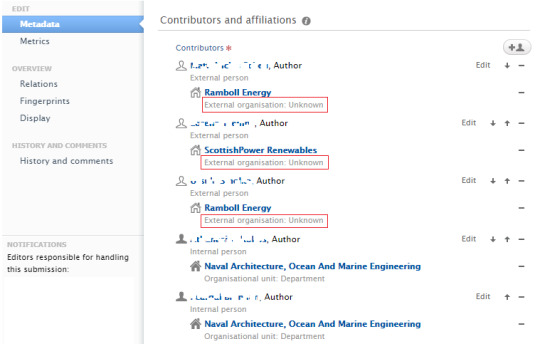
Note how the industrial affiliation entries in the record above for ‘EU industry’ and ‘UK Industry, Commerce, Public Corporation’ – categories defined for external affiliations in the CRIS – have instead been coded as ‘Unknown’, making it impossible to track eg the institutional co-authorships with EU industry via searches against this metadata element. This is again hardly the researchers’ fault – it’s not for them to deal with these metadata intricacies. If the research support team at the library were able however to reallocate some of its time to make sure these affiliation entries were adequately coded in the system, they would be able to handle it just fine. This would automatically place them in a position to address the pressing question of how the UKRI 5-year Gold Open Access funding policy may have impacted this critical indicator for assessing the effectiveness of such policy. The citation advantage is the default indicator we use to try and assess the academic impact of (Gold) Open Access, but as per the approach described in the previous post, this complementary indicator for the number of institutional co-authorships with industry would be both more precise and more in line with the objectives of the funding exercise. If we don’t do this kind of analysis ourselves, others will do it for us using our own data and will sell it back to us among loud complaining among Open Science advocates about the outsourcing of key business intelligence-related workflows. We seem to be experts in this sort of thing. And this is already happening, though it’s so beautifully done that one cannot find any reasons to complain. These are our own (extremely expensive, publicly-funded) research facilities, our own staff who are striving to have them used by industry as per the research funders’ recommendations, our own publications based on the data coming out of such facilities and instruments and our own collaborations with external stakeholders though. It should ideally be our own analysis too.
1 note
·
View note
Note
what do you plan on doing after law school? i'm a sophomore and i'm thinking about trying to go to law school because its the only thing i'm actually interested in. but i have no idea what i would do post-law school. i know for sure i could never be a trial lawyer. i don't know anyone that's gone to law school so i don't know how important it is to have a post-school career planned out.
I get variations on this question off anon pretty often so i’ll try to answer in more depth than this requires for future ref...so from what i gather you want some idea on what post-law school job choices look like? and also some advice about strategizing?
So first, what are job options other than the Atticus Finch?
So first: Most people who work at “trial” firms/non-profits (as i will be) do not go to trial. Going to trial is rare and desirable so you could easily go into trial/litigation (meaning: bringing or defending specific lawsuits) and spend your time researching, writing, and occasionally arguing specific parts of the case in front of a judge rather than going to trial (even the arguing part is something others will be more than happy to do!)
Second: If the thing that makes you go “I don’t want to be a trial lawyer” is more “I don’t want to deal with cases/clients at all!” and not “I don’t like the idea of trials specifically or performing for people.” there are plenty of other lawyer jobs but this requires more research on your part. most organizations/non-profits have a legal policy department...you research and write policies your org should pursue and then strategize on how to make it happen. you can work in any government agency or for any lawmaker as a legislative person....you can even work for a creative company or start-up helping with licensing/content creation. there are a lot of options but the answers are too infinite and dependent on your own strengths and interest
Personally, i AM going be a trial lawyer (specifically litigating to make good law in the intellectual property area, bringing civil rights violations, and hopefully eventually impact litigation...which is just a fancy way of saying social policy-based lawmaking through lawsuits) but i could and do see myself exploring other things in the long run!
How to strategize for law school:
i decided to go to law school because it’s the exact area of the Venn diagram that overlaps my particular strengths/abilities; stuff i like to study; and power to make the world a better place while also doing day-to-day stuff i enjoy. i also went straight from college but (i’m def repeating something i’ve said a lot on this blog) i worked significantly during college. first an unpaid internship but subsequently paid research assistant/production assistant/analyst jobs at various orgs (e.g., i worked for small documentary unit of bcc world news and an education non-profit). i do think that was important because FIRST OFF it helped me see the type of work i’d be doing going into an entry-level job, which sucked. the lawyers got cooler work straight out of law school and i just didn’t want to work a couple of years at a job that i didn’t like if i got in and could just become a lawyer. and SECOND yeah it definitely helped me get in...if you’re not in a position to intern (which is like a ridiculous requirement of modern day life when unpaid) or do substantive paid work, you should definitely start thinking of post-college jobs in your area of interest (doesn’t matter so much what that is as long as you are consistent with it, can explain why you are passionate about it, good at it, and show strong writing skills).
in terms of what to do in college...same advice. pick your thing and be good at it! it generally doesn’t matter all that much what that “thing” is as long as you can pursue it passionately, diligently, excel at it and explain how it connects to law school (anything in the world can have a law school link so you shouldn’t let this affect your decision too much). you can always completely change track in law school (frankly once you get to law school no one knows what you did before...no one cares what you studied or where you worked) and even after but law schools def wanna see people who can go after shit and who bring something very specific (or several complementary “somethings”) to the table.
i personally love law school but it’s not for everyone. i did well in college but like...never enjoyed doing the work associated with subjects i chose to study because i was supposedly super invested in them. i felt most of it i could have just learned by following the syllabus and reading a few of my professor’s papers. but pedagogically law school is so engaging to me (like i even pay attention in class...) and 90% of my professors have clearly put so much thought and effort into how to develop our skills/thinking/knowledge in their class. BUT two of my super close law school friends don’t like it...or at least not 1st year because 1st year classes are really theoretical and rule-based and seem disconnected from policy work...so unless you get professors who can make the social connection (or you can make those connections yourself and that’s enough for you) it doesn’t get interesting until 2nd/3rd year when you can just do whatever.
if you’re not sure about law school i definitely recommend thinking about it and doing jobs/internships/volunteer-work in some area that involves a law angle...and then think, do i like this? do i hate this but like the work the lawyers are doing?
8 notes
·
View notes
Text
Thursday 24 Nov 2022 - Stuff to do...
The Principle Aim for today is for all learners to continue to make progress with individual proposals for intended Action Research projects ready to resubmit for Formative Assessment (using guidance on feedback handout provided last week, as well as deriving from planned feedback peer activity).
Additionally, pertinent to the principle aim above, by the end of the session, all learners will also have revisited core learning theories (establishing prior knowledge and recapping in preparation for Action Research Report progression purposes) and as a result, identify relevant theories, models and/ or concepts aligned to trainee’s chosen subject-specialism and research topic (to include in version 2 of your proposal).
Learner Objectives for the day are to:
1.If received, contribute to discussion on data received from UCLan questionnaire from last week. Identify and address issues raised moving forwards. EW to action plan (based of feedback triangulated).
Remind trainees to arrange #Ob7 (mentor lesson Ob ASAP – use blank proforma on Teams) over the next couple of weeks. Once reports are complete, ask mentors to send to EW for moderation purposes.
2.Complete the ‘Breathing Life into Theory’ exercise to help strengthen proposal redrafts and instil greater trainee confidence to begin the data collection phase. (3 x) 2-minute activity – timed. Share findings. What have we learnt from the process?
Ref: Teams, UCLan General Channel Folder 4 (Nov 22)!
2b.Complete revision table recapping on learning theories - to align to subject-specific research content within proposal and contribute to discussion afterwards.
3.Participate in proposal peer-review activity. To assess (annotate) for clarity and reader-friendliness of the proposals at this stage (preparation for resubmitting Version 2).
4.Read through Research Ethics (McNiff) Handout. Distribute and discuss. Clarify and respond to trainee questions where appropriate.
5.Read through Harvard Referencing Handout (BU citation). Distribute and discuss. Clarify and respond to trainee questions where appropriate.
6.PM: Complete UCLan paper-based student feedback questionnaire (sorry, yes another!). EW instructed to scan and send onto Tanya.
7.Trainees to revisit proposals based on two activities and redraft accordingly. EW to support and guide individual trainees who may still be struggling with write-up for various reasons.
TUTORIAL: PM: Between 4.30-5pm: EW to carry out a one-to-one tutorial with Amy H (to discuss report and provide feedback on lesson observation according to UCLan proforma). Actions to be negotiated and documented under 4 UCLan curriculum strands.
EW to send final copy via email. EW to remind Amy to upload final copy onto her Portfolio of Professional Achievement (PoPA) and update ILP - including reflections of ETF criterion.
8. (Time Permitting) As a Year 2 refresher task, trainees to design a starter activity (integrating Eng, Maths or digital literacy starter activity which demonstrates E&D, British Values or sustainability) to share findings with the group. Post discussion and on completion, adapt and upload onto PoPA.
Ref. UCLan Teams, General, Section A, PT suggested SOW to access relevant links.
OR
Portfolio check (cross ref. hard copy SOW for Term 1 against evidence you have on PoPA). Please address those identified if not uploaded already.
0 notes
Text
if you want to existensing with money about my music-artinas & gardening here please purchase paper publications from amazon.com or ingramspark.com by copying & pasting in your web browser's address bar. the links are- https://shop.ingramspark.com/b/084?params=C8AfUaeUGs7cMsjxOZRYVqXtHyvxXIKdsN0ZXpuIFE1 & some items on amazon are fun & they are publishing photographs of gals on their site and ingramspark.com is usually not and having boring graphics in their e-mails? , though they give artinas artists most of the money?- https://www.amazon.com/s?k=andrea+arthena&crid=1E085SF36BB1E&sprefix=andrea+arthena%2Caps%2C134&ref=nb_sb_noss we L&Q spaces hips is my music site- Check out "we L&Q spaces hips" on Mixcloud https://www.mixcloud.com/heatherestylesofteffects/ & https://www.dailymotion.com/seasidesurrealrides if i could find groups or organizations that help survivors of gun violence with outside physical art, music and sport therapy and funding for bullet resistant clothing in the u.s. & they do not only wear t-shirts with text only mostly i shall give 10% of my money from my publications to theirselves, when they exist in a google or yahoo search. i am not a fun orginizer or public speaker , if you are & are into amphithereatres about mostly music & artinas outside & experigal sport later , you could electragalaxie letter me- [email protected] . i have been violently attacked over 50 times if you count jr. highschool and i know i have only hit one person first i, ithink , in jr. highschool. i really try to avoid being mean & i want earth to not be very mean. if you are vegan, not part of honking horn anti-music gangs, & think some of what i am publishing here & on youtube.com we could also chat on zoom , as its name is funny , though i am not into it as mostly a as scocial interaction. to stop powerful war machines whether they are r.o.v.s , driven by people, or autonomous. i think i have to pay to post on tumblr.com now, i can't yet as i am a mostly vegan which is spending a small amount of money on beer & ale, funner for me than food only- ideas about marine power as well
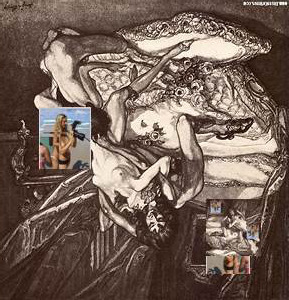
IDEAS ABOUT MARINE POWER as well- i think most electricity could existensing from star powering panels from geothermal from where there was fracking or not totally without poisioning earth's water much. i think scientists & engineers have thought about these ideas and are researching theirselves and them . a cone shapping screen filter pointing away from turbines to stop sea creatures or heavier sea debries than plastic bags mostly only? (i do not think sea coral or crochet are 2 dimensional, i think it is really difficult to find anything one dimensional), from getting in turbines that could also have blades on the same turbine that change similar to a butterfly's wings , though only four times a day if it was a tidal machine. ismaller rivers in the u.s. that do not have dams yet and have migrating fish, alaska is an example could contruct bridges with arches and the turbines could existensing at the bases of the bridge infrastructure and water ,small boats and fish could pass under the marine power aray. i think if these were near cities or towns they could be similar to a village shoppe festival as in venice italy ? i think a question climate change scientists and marine power scientists and engineers could calmly discuss and reseach mostly outside is if there are a bunch of large marine power macines effecting earth's ocean currents how will that effect earth's weather and sea creatures that ride tides similar to surfriders california organization and their token nerd, could also reseach as well besides squim, or sequim scientists in washington state? i think marine power machines that are not in significant weater currents frrom the ocean and are vertically basing could existensing, though i think star electricity and geothermal energy craaeting star electical panels is easier especial as most of thae wiring on earth in on land, and wireless electicity on large scales and with high voltages could be a weapon. what i think is not mean about marine power is whales with or without whale snot though slightly with you eoo & lady whale song is ships that usually smash into whale could be wrned that whales are in that pat of the inland seas or ocean, it is sorta of a question about what sonar or what hydrophone is communtating whith people. whaat elae i think i was galcing at was hydrogen being electrolysiizing to power power boating by star power electricals. to stop powerful war machines whether they are r.o.v.s , driven by people, or autonomous. hi I know people , think not only men have thought of how to stop powerful war machines whether they are r.o.v.s , driven by people, or autonomous. in the movie Star Wars- empire strikes back their gluey teen boy models in future billionare movies with few female characters, princesses or not, fly around large war machines driven by people with cables and bring them down. duh. it is like those machines were white flamingos with four legs. and, and you should never start a sentence with and it is not funner enough? did you want to write or video message about these ideas. that is not a mean science contest about patents that go nowhere and are put into a category of national securities only? I'm not sam & I am, that is I am me, not sam or thee.
if you put or putt, though I'm not sure where golf is involving theirselves, besides that,s where boaters sleep while awake from bugs in a board room , though in the bushes without not only mosquitos i think if you do not have a harpoon with strong steel cable , you could try to stop land based killer robots with strong fishing line and if you do not even have a long stong rope you could existensing stoping them wearing bullet resist clothing and with a long extension cords, though they could have electric weapons. Sea-pals whatevering aye?- retrieving spheres with dimples ladys garden golf? in a driving range pond. there is carbon fiber watering tubes ( that is not repulsive bymork and mindys show and there is not only nano , theres e micro thers very small fun particles ? extensing in scopes without poisoness mouth wash or male dominating hip hop rap rock) cabling in nasa experigalaxie or most likley experimental videos. videos on video showing several whatever stronger than steel cables, suposely whteveringly. these technologies mixing with lead or theirselves as a whatevering cage around a killeer robot , an isle , a keel? no! silly string in peoples possession ( with heavy weight net floating fast from female sources with heavy weights around each net to bring that killer robot down or at least sto it near its struggling tracks on or off tracks, & r.o.v.s with carbon whatevering tibe sillystrings or thicker cables not the size or bricks , they couldn't fit thought the nets entangle the net saws or silly string snippers & also tru ti to entangle the motion wheeles shoelded by heavy metal , mostly a male music genre that i dont care is stopped along with rap hip hop mailestrome smyths yhths? no the meadia ive seen on mttv, and now back to how coukd people stop killer autonomous robots on eart's surfaces? . these robots will have silly string clippers or scissors stowed in their tank like bodies to clip very strong silly strings , thussy you should existensing with silly strings that jam not only their movement machine joints , though as welling their radioscopy eyes and snipper silly strings openings..
have fun at & after work , these problems are so mean you have to try to existensing in fu at work as welling. you could video message me if you could figure that in an existensing fun that is 90% fun & in my existensing that is mostly not violence, though in the media thats where money goes and it shows , though is it a deep fake violence war movie with new technology?. i was watching videos and mostly photos without music palsof the ukraine and russsia fighting and they appear to be real violence and women don't bwear fun clothes there and look scared on youtube. i perfer to galnce at theirselves , though scaced, than warmonger male leaders in their polical talking and then sending war machines , though they are neither much fun. write me about heavy net weight deployers landing on war machine on earth's surfaces or similar ideas about stopping flying war machines and landing them back where they came from without blowup bummers and a bunch of hummers and tanks going to investigate. have fun after work
1 note
·
View note
Text

I posted 153 times in 2021
57 posts created (37%)
96 posts reblogged (63%)
For every post I created, I reblogged 1.7 posts.
I added 160 tags in 2021
#signal boost - 40 posts
#jeremycore - 21 posts
#personal - 18 posts
#fnv - 18 posts
#jeremy - 17 posts
#fallout - 11 posts
#embroidery patch - 9 posts
#another happy customer - 9 posts
#from sketchbook - 9 posts
#self rebagel - 8 posts
Longest Tag: 71 characters
#i can't belive i had to forgetrt my password right when this was posted
My Top Posts in 2021
#5

All you’re seeing is made by hand in high end paper, a bit of ink and lots of patience.
WILL DRAW
- Characters (humans and anthros, humanoids in general)
- Fantasy, SciFi, Cyberpunk, Steampunk, Original Characters, Cannon Characters, RL people,you name it, I will draw.
-Detailed Clothing (the more layers and details the better)
- Art for any purpose (Printing and web including, Book covers, Illustrate Fanfics, Faceboook/ any page header, Decorations, Again, if you want to do something and need a cool art, I’m your guy)
-SFW/NSFW (fluff things, angst things, cute things, kink things, the sky is the limit)
WILL NOT DRAW
- Vehicle/Mechas (androids/cyborgs are fine but ask me first)
- Landscape/ Scenario
- Ref Sheet/ Concept Art
More info under the cut
I know I said I’m fine with NSFW content, but I have my limits which are : Underage, Non con, Dub Con, Extremely Gore, Anything with hate speech, RL ships, and anything that can bring all the boys to my yard and not to have a milkshake)
Keep in mind this take time and I can’t simply give your art in a blink of an eye, but I will keep you updated in any progress I do, you can also request to see the progress , at least one time each two days starting when the sketch is approved.
My process for creating is simple:
- Research
See the full post
68 notes • Posted 2021-05-17 21:05:52 GMT
#4

PRIDE CATS!
15 U$ Each! (10 U$ patch + 5 U$ Shipment)
5x5 cm aprox.
69 notes • Posted 2021-03-13 00:40:41 GMT
#3
PATCH SALE

Or "Lima embroidered too much during quarantine"
All of the patches above for 15 U$ each! Shipment and tracking code included.
Pls consult me first cause due to the Covid situation some countries are not receiving mail from here.
79 notes • Posted 2021-03-25 02:01:42 GMT
#2

Commission for @the-laridian fo their oc Gunnar and Arcade :)
This was so fun for draw, yall have no idea.
A4 Paper,Black Ink
COMMISSIONS ARE OPEN
CHECK FIXED POST
99 notes • Posted 2021-06-01 23:00:09 GMT
#1
Help NB transmac + cat move out
Okay i know i already made a post like this but this one I'm doing in a less rushed way. So I'm Lima and i live in a small house with six shitty people and three cats (the chonkiest is mine)
I was in a very dark place a while ago and since I started therapy , the doc "gently suggested" for me to get the fuck out of here fast as I can cause apparently live in a fucked up place can mess up your head.
You see, four of the six people are the whole package: Terf, Homophobics, Racists, Xenophobics, Incel, Narcissistic, you name it, we have everything ( the other two are kids). Not only that but every day i step on eggshells to avoid to be stepped on. Literally.
So yep, I'm signal boosting all my services, i still open for Art Commissions and Patch Commissions, but also i got very bored in this quarantine so i have some stuff ready to ship if anyone is interested.
My Ko-Fi is always open too (link in my bio)

- "Be Gay, Do Crime" 4x10 cm aprox.
- "Then Perish" 4x11 cm aprox.
- "Toad with mug" 6x6 cm aprox.
- "Vault Boy head" 5x5 cm aprox.
- "Shank a Bitch Chick" 5x5 cm aprox.
- "Gray Cat" 4x7 cm aprox.
- "Lesbinyan" 4x6 cm aprox. (SOLD)
- "Nyanbinary" 4x6 cm aprox.
- "Transmeow" 4x6 cm aprox.
Each for 20 U$ (15 U$ Patch + 5 U$ shipment)
Payment via PayPal invoice only.
172 notes • Posted 2021-01-10 04:06:32 GMT
Get your Tumblr 2021 Year in Review →
1 note
·
View note
Video
youtube
Two Vortex Rings Colliding in SLOW MOTION - Smarter Every Day 195 This took 4 years to recreate. 12 Hour edit here: https://youtu.be/Cm9l8-qngjM Please subscribe if this video earned it: http://bit.ly/Subscribe2SED Get a free audio book! http://www.audible.com/Smarter ⇊ Click below for more links! ⇊ High Resolution images will be provided to the Patrons of Smarter Every Day at: https://www.patreon.com/posts/high-quality-19568610 http://www.patreon.com/smartereveryday If you’d like to support big adventures like this, consider becomingbeing a Patron! I’ve been chasing this problem for over 4 years. The 12 hour edit chronicles the entire process after David Linderman and myself started working on it in earnest. https://youtu.be/Cm9l8-qngjM People don't tweet me their thoughts about videos enough. I'd love to hear from you. http://twitter.com/smartereveryday Smarter Every Day on Facebook https://www.facebook.com/SmarterEveryDay Smarter Every Day on Patreon http://www.patreon.com/smartereveryday Smarter Every Day On Instagram http://www.instagram.com/smartereveryday Smarter Every Day SubReddit http://www.reddit.com/r/smartereveryday Song “Rings in Rings in Rings” by Gordon McGladdery of A Shell In The Pit Listen to it on Spotify: (It helps https://open.spotify.com/track/5Itp2wFFmI6xtIAc54F1rM All A Shell in the Pit music available at: https://ashellinthepit.bandcamp.com/track/rings-in-rings-in-rings http://ashellinthepit.bandcamp.com/ ~~~~~~~~~~~~~~~~~~~~~~~~~~~~ GET SMARTER SECTION A Vortex Ring is also called a Toroidal Vortex https://en.wikipedia.org/wiki/Vortex_ring Original Research Paper by T. T. Lim & T. B. Nickels (Published in Nature 1992) http://202.118.74.190/~elizabeth/Docs/34_Instability_Head-on%20collision_of_large_VR.pdf Governing Equations of Fluid Mechanics http://www.eng.auburn.edu/~tplacek/courses/fluidsreview-1.pdf Numerical Analysis of this phenomena http://fluid.itcmp.pwr.wroc.pl/~znmp/Publikacje/JP_2014_Kudela_Kosior.pdf Interesting Research Papers on Vortex Ring Reconnection https://pdfs.semanticscholar.org/3721/e67f5bf8e88a47e2241058c7e3cc064c5e8a.pdf Other Videos created by Dr. T T Lim http://me.nus.edu.sg/dept/limtt/videogallery.html Flow Visualization, A Book by Dr. T T Lim https://www.amazon.com/Flow-Visualization-Techniques-Examples-Second/dp/1848167911/ref=mt_hardcover?_encoding=UTF8&me=&qid=1529505335 Why we typically don’t talk about angular momentum in fluids. https://physics.stackexchange.com/questions/127712/why-dont-we-talk-about-angular-momentum-at-all-in-fluid-mechanics We used a computer controlled cylinder to pump fluid behind a rubber membrane to fire toroidal vortices out of the vortex cannons. We fixed one of the vortex cannon in a stationary position, and used a multi-axis microscope stage to align a second cannon to it… which sounds incredibly easy, until you realize that DYE density was an experiment all on its own. If the density of the dye mix was light than water, the vortex would go up. If the dye was more dense than water the vortex would fall. We had to overcome SO MANY VARIABLES to overcome and we basically spent about 4 hours figuring each variable. Water/dye temperature differential Water turbulence Water turbidity (cloudiness or haziness of a fluid) How to reset the aquarium Cannon Spacing Cannon Nozzle Cannon Shape Dye homogeneity in the vortex itself The piston displacement volume The piston stroke speed Rubber diaphragm tension, would make one side fire faster than the other. Water or air to drive diaphram? Firing speed (too slow and they drift, too fast and turbulence tears apart secondaries) We did a complete redesign of the cannon 3 different times. The Dye loading method was changed several times At times We tried to maintain negative pressure on the cannon chamber… we also tried to put shutters on the front of the muzzle. Ultimately I decided it was ok to live with dye dripping out of the front. We had to premix the dyes and eventually we got there. It got to the point where we didn’t even really know what success looked like and always thought we were there. ~~~~~~~~~~~~~~~~~~~~~~~~~~~~ The thought is my efforts making videos will help educate the world as a whole, and one day generate enough revenue to pay for my kids college education. Until then if you appreciate what you've learned in this video and the effort that went in to it, please SHARE THE VIDEO! If you REALLY liked it, feel free to pitch a few dollars Smarter Every Day by becoming a Patron. http://www.patreon.com/smartereveryday Warm Regards, Destin
1 note
·
View note
Text
Fwd: Postdoc: HongKongU.PathogenEvolution
Begin forwarded message: > From: [email protected] > Subject: Postdoc: HongKongU.PathogenEvolution > Date: 4 May 2021 at 06:32:39 BST > To: [email protected] > > > > Applications are invited for appointment asPost-doctoral Fellowin the > HKU-Pasteur Research Pole of the School of Public Health(Ref.: 503788), > to commence as soon as possible for one to two years, with the possibility > of renewal subject to satisfactory performance. > > Applicants should possess a Ph.D. in epidemiology, computational > biology, virology, microbiology, antimicrobial resistance, genomics, > bioinformatics, biostatistics or a related discipline. Preference > will be given to those with a strong background in phylogenetics, > population genetics, microbial evolution, or epidemiology. They should > have experiencein next-generation sequence analysis using programming > languages such as R or python. They should have a good command of written > and spoken English, strong communication skills, and a demonstrated > record of publishing academic research papers. They should be organized, > highly motivated, and able to work independently as well as in an > interdisciplinary team. > > The appointee will join Dr. Dhanasekaranขs research team to study the > molecular epidemiology and evolution of infectious diseases.He/She will > analyse genomic data from surveillance activities, linking clinical, > epidemiological and genomic data for prediction of disease severity, > transmission modelling and comparative genomic evolution in a phylodynamic > framework.He/She will contribute to the design and implementation of > virus surveillance and genome sequencing projects in collaboration with > international experts in the field. > > A highly competitive salary commensurate with qualifications and > experience will be offered, in addition to annual leave and medical > benefits. > > The University only accepts online applications for the above > post.Applicants should apply online and upload an up-to-date C.V. via the > link below.Review of applications will start on May 12, 2021 and continue > untilJuly 31, 2021, or until the post is filled, whichever is earlier. > > https://ift.tt/3efNGsV > > kedwards > via IFTTT
0 notes
Photo

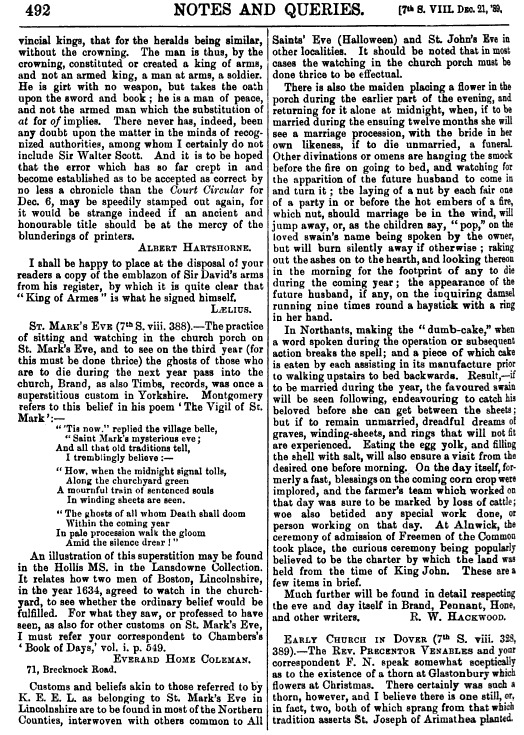
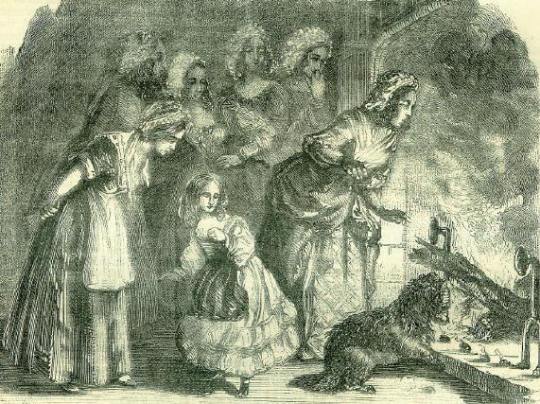
Hi everyone, here are my (copious) notes on St. Mark’s Eve! Listen to Ravin’ Girls Episode 1: Finicky Camaros ( https://ravingirls.tumblr.com/post/166065653944/ravin-girls-ep1-finicky-camaros-shownotes) for the discussion. -N
Ravin’ Girls Ep. 1 - Deep Dive: St Mark’s Eve
From Wikipedia: St. Mark's Eve is the day before the feast day of St. Mark the Evangelist. In liturgical Christian churches, this feast of St. Mark is observed on 25 April of each year; thus St. Mark's Eve is 24 April.
Trivia:
Maggie has said that she discovered the folklore of St. Mark’s first through researching ley lines, and that information influenced the creation of Blue’s “curse”/prediction of death/true love.
James Montgomery (pub. 1906) and John Keats (1819) both wrote poems about St. Mark’s Eve (Keats’ is unfinished). Montgomery’s work is more relevant to how the night is treated in The Raven Boys. Ref. poem excerpt (1) below.
There were several fortune telling devices associated with St. Mark’s Eve, all of them seeming to indeed revolve around true love or death. Of note, Ethel Rudkin (1936) wrote in Lincolnshire folklore records: “On St Mark’s Eve all those who are going to die, or to be married, can be seen by anyone who watches in the church porch at Midnight, as they come into the church in spirit on that night.”
This appears to be a mostly English custom, from the 17th through the 19th century.
Ghosts can be seen entering a church between the bell tolls of 11pm and 1am; supposedly the ones that are to die sooner appear earlier in the night. Watchers are admonished to keep silent, which seems to be a theme for all of the fortune telling.
Some say you need to fast, some say you need to wait three nights (in a row? On different years?)
A Vice article tells a story of a clergyman who saw his own spirit on the corpse road one St. Marks vigil; see excerpt (2) below.
Chamber’s Book of Days notes a different way to tell the deaths: a spirit will walk through the hearth ashes, and then the shoes of that person would be marked by ash the next morning. It also notes that a “malicious or wanton person” could take the shoes to the hearth themselves, leading another person to believe that they are to die in the coming year.
Unmarried women can predict their future husbands in several ways on St. Mark’s Eve:
Hanging her nightclothes/smock before the fire, and an apparition of her future husband would appear to turn the smock. (Fire scrying is a type of scrying.)
Setting a nut in the fire, saying the name of the intended and a charm (“If you love me, pop and fly, If not, lie there silently.”), and if the nut “hops” away from the fire then it is true love, if the nut is consumed then it’s not meant to be. (See engraving of divination by nuts taken from the Chambers Bros. "Book of Days", Edinburgh, 1869)
The making of a “dumb cake” The name may derive from “doom”, meaning “fate” or “destiny”, though I also saw it attributed to the fact that you’re not supposed to speak while making the cake. The “Dumb Cake” is associated with several holidays including St. Agnes’ feast day. Many different charms or recipes can be found, all seemingly made with inedible ingredients. Read “Notes and Queries” recipe below, excerpt (3).
There are some reports of fatalities from Dumb Cakes due to the inedible ingredients.People also choose to put in herbs/plants that had the potential to be hallucinogenic (and poisonous), mistletoe being chief among them.
There is a small fly named after St. Mark that hatches during this time, lives a very short time, then buries itself underground.
Sweetly, though unrelated to the English folklore, Venice has a tradition of exchanging rose buds as a symbol of “love eternal” on St. Mark’s Eve.
1. The Vigil Of St. Mark, John Montgomery (excerpt):
" 'Tis now," replied the village Belle,
" St. Mark's mysterious Eve ;
And all that old traditions tell
I tremblingly believe ; —
" How, when the midnight signal tolls,
Along the churchyard green '
A mournful train of sentenced souls
In winding-sheets are seen.
" The ghosts of all whom death shall doom
Within the coming year,
In pale procession walk the gloom.
Amid the silence drear.
2. Vice Article:
Story from Jacqueline Simpson, author and English folklorist, “There was a young clergyman who was curious to find out about this. He knew there was an old man in the village who understood second sight and magic and so on, so he persuaded this man to tell him what to do. The old man said he had to watch in the porch. So at the right date around midnight, there he was watching and he saw members of his congregation there, wraiths coming in, and then… he saw… his own wraith! Mwahahah! He went home and was never the same again. He was dead within the year!”
3. “Notes and Queries” published a recipe for St Mark's Eve “Dumb Cake” (1890):
(Transcription by -N, see scanned text)
I do not know if the following recipe for dumb-cake has appeared in “N & Q”. I obtained it from a lady who helped to make such a cake nearly sixty years ago. It is much more elaborate than that spoken of in “Bracebridge Hall” and may be of interest to your readers.
It should be made by four persons, and each must supply these things: of sand, flour, bran, salt, and brickdust; each a thimbleful; the parings of their own nails, and some hair from the back of the head cut up fine and strewn in. This must be mixed to a stiff paste on a sheet of writing paper, which must be gilt edged (this seems quite an important feature in the charm.)
When made, the cake must be transferred to a clean sheet of paper and marked with a cross (like the old pennies) by the four persons, each of whom must take no more than her own share. Then each must mark her own initials in one of the four quarters and also the initials of the man she hopes will be her husband.
Not a word must be spoken or a sound made during the whole process, which, ought to have said, should begin at eleven o’clock precisely. Each person takes a corner of the paper and carefully carries the cake to the front of the (fire?), where they must have a pan or an iron rest to receive it They must sit at some distance from the fire, and at intervals of five minutes must take in turn to go and turn their own initials to the fire, until each corner is done.
But for the last quarter of an hour before midnight no one must move; each must sit in absolute silence. A laugh or a word would be fatal. Then as the clock strikes twelve, if she is to marry the man whose initials are on the cake, he will suddenly appear and speak to her.
S. Illingworth Butler
Pg. 67, “Notes and Queries”, Saturday, January 4th, 1890 (Price fourpence)
Of note, this publication also included an article about John Smith and Pocahontas (for historical perspective).
Links:
Wikipedia: https://en.wikipedia.org/wiki/St_Mark%27s_Eve
Maggie talks St. Mark’s Eve: http://ravenboys.tumblr.com/post/34241110284/maggie-stiefvater-answers-questions-about-raven
Vice article: https://www.vice.com/en_us/article/dpxnm7/doomed-to-die-on-st-marks-eve
James Montgomery's poem: http://tellinghistory.co.uk/content/vigil-st-mark
Keats poem: http://www.keats-shelley-house.org/en/works/works-john-keats/john-keats-the-eve-of-st-mark
Incredibly well researched list of traditions with primary sources, even included reference to someone who charged to tell others if they were to die: https://traditionalcustomsandceremonies.wordpress.com/2014/04/30/custom-demised-porch-watching-on-st-marks-eve/
Good overview of folklore: http://www.dailygrail.com/Guest-Articles/2015/4/Saint-Marks-Eve
Venice customs and English divinations: http://www.conviviobookworks.com/blog/category/st-marks-eve/
Book of Days: http://www.thebookofdays.com/months/april/25.htm
“Notes and Queries” Dumb Cake Recipe: https://tinyurl.com/y7l4efhy
Dumb-cake fatalities: http://www.foodsofengland.co.uk/dumbcake.htm
Other sources:
“Dumb Cake” for foretelling future husband: http://www.theoldfoodie.com/2009/04/dumb-cake.html
Overview of traditions: http://www.historiavivens.eu/2/traditions_of_st_mark_in_europe_1220021.html
The Penguin Guide to the Superstitions of Britain and Ireland: https://tinyurl.com/y9pvbcj4
#ravin' girls#raven cycle podcast#episode1#Deep Dive notes#St. Mark's Eve#raven cycle research#way more information than anyone ever asked for
147 notes
·
View notes
Text
Bitcoin Facts #1: Silk Road, FBI Hacks and the Good Old Days 🚀

youtube
Bitcoin was born 12 years ago on 31 Oct when Satoshi Nakamoto published the original BTC White Paper. In this video we celebrate the early wins and obstacles faced by this revolutionary new blockchain. Happy birthday Bitcoin! Here’s to many more years and many new ATHs! #Bitcoin, #SatoshiNakomoto, #FBI
Cryptocurrency And Bitcoin Visa Card – GET $50 FREE ON ► CRYPTO.COM https://platinum.crypto.com/r/ab *Code is AB
Trade On Binance! ► https://www.binance.com/en/register?ref=UAMKZ47P *Code is UAMKZ47P
Trade On AAX ► AAX EXCHANGE https://www.aax.com/invite?inviteCode=zpqm9Fn03yVG
CRYPTOCURRENCY MARKET PRICES AND DATA ► COINGECKO https://www.coingecko.com/en
TRADE BARCELONA FC, JUVENTUS AND UFC TOKENS ON CHILIZ EXCHANGE ► https://www.chiliz.net/register/FZAkA1 *Code is FZAkA1

NOTE If you use the above referral links, we receive a commission at no additional cost to you.

TOP CRYPTO NEWS – https://www.altcoinbuzz.io

FREE NEWSLETTER – http://eepurl.com/dnIEz1

TWITTER – https://twitter.com/Altcoinbuzzio

FACEBOOK – https://www.facebook.com/altcoinbuzzio

TELEGRAM – https://t.me/joinchat/altcoinbuzzarmy
References: https://bitcointalk.org/index.php?topic=822.0 https://hackernoon.com/bitcoins-biggest-hack-in-history-184-4-ded46310d4ef https://news.bitcoin.com/bitcoin-history-part-10-the-184-billion-btc-bug/
The Curious Case of 184 Billion Bitcoin
https://bitcointalk.org/index.php?topic=822.0
Bitcoin Facts: 40 Fun & Interesting Bitcoin Facts
https://www.blockchain.com/btc/address/1F1tAaz5x1HUXrCNLbtMDqcw6o5GNn4xqX https://www.blockchain.com/btc/address/1FfmbHfnpaZjKFvyi1okTjJJusN455paPH https://en.wikipedia.org/wiki/Silk_Road_(marketplace) https://www.theverge.com/2013/10/4/4803732/someone-found-the-fbis-bitcoin-wallet-silk-road https://www.aljazeera.com/indepth/opinion/2013/10/fbi-bitcoin-address-2013102862850865999.html
Disclaimer: The information discussed by Altcoin Buzz is not financial advice. This is for educational and informational purposes only. Any information or strategies are thoughts and opinions relevant to accepted levels of risk tolerance of the content creators/reviewers and their risk tolerance may be different than yours. Altcoin Buzz is not responsible for any losses that you may incur as a result of any investments directly or indirectly related to the information provided. Please do your own due diligence and rating before making any investments and consult your financial advisor. The researched information presented we believe to be correct and accurate however there is no guarantee or warranty as to the accuracy, timeliness, completeness. Bitcoin and other cryptocurrencies are high-risk investments so please do your due diligence. Copyright Altcoin Buzz Pte Ltd. All rights reserved.
The post Bitcoin Facts #1: Silk Road, FBI Hacks and the Good Old Days 🚀 appeared first on BLOCKPATHS.
source https://blockpaths.com/commentaries/bitcoin-facts-1-silk-road-fbi-hacks-and-the-good-old-days-%f0%9f%9a%80/
0 notes